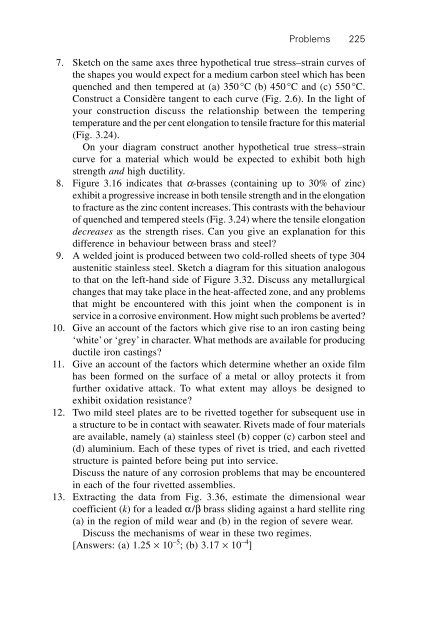Materials for engineering, 3rd Edition - (Malestrom)
Create successful ePaper yourself
Turn your PDF publications into a flip-book with our unique Google optimized e-Paper software.
Problems 225<br />
7. Sketch on the same axes three hypothetical true stress–strain curves of<br />
the shapes you would expect <strong>for</strong> a medium carbon steel which has been<br />
quenched and then tempered at (a) 350°C (b) 450°C and (c) 550°C.<br />
Construct a Considère tangent to each curve (Fig. 2.6). In the light of<br />
your construction discuss the relationship between the tempering<br />
temperature and the per cent elongation to tensile fracture <strong>for</strong> this material<br />
(Fig. 3.24).<br />
On your diagram construct another hypothetical true stress–strain<br />
curve <strong>for</strong> a material which would be expected to exhibit both high<br />
strength and high ductility.<br />
8. Figure 3.16 indicates that α-brasses (containing up to 30% of zinc)<br />
exhibit a progressive increase in both tensile strength and in the elongation<br />
to fracture as the zinc content increases. This contrasts with the behaviour<br />
of quenched and tempered steels (Fig. 3.24) where the tensile elongation<br />
decreases as the strength rises. Can you give an explanation <strong>for</strong> this<br />
difference in behaviour between brass and steel?<br />
9. A welded joint is produced between two cold-rolled sheets of type 304<br />
austenitic stainless steel. Sketch a diagram <strong>for</strong> this situation analogous<br />
to that on the left-hand side of Figure 3.32. Discuss any metallurgical<br />
changes that may take place in the heat-affected zone, and any problems<br />
that might be encountered with this joint when the component is in<br />
service in a corrosive environment. How might such problems be averted?<br />
10. Give an account of the factors which give rise to an iron casting being<br />
‘white’ or ‘grey’ in character. What methods are available <strong>for</strong> producing<br />
ductile iron castings?<br />
11. Give an account of the factors which determine whether an oxide film<br />
has been <strong>for</strong>med on the surface of a metal or alloy protects it from<br />
further oxidative attack. To what extent may alloys be designed to<br />
exhibit oxidation resistance?<br />
12. Two mild steel plates are to be rivetted together <strong>for</strong> subsequent use in<br />
a structure to be in contact with seawater. Rivets made of four materials<br />
are available, namely (a) stainless steel (b) copper (c) carbon steel and<br />
(d) aluminium. Each of these types of rivet is tried, and each rivetted<br />
structure is painted be<strong>for</strong>e being put into service.<br />
Discuss the nature of any corrosion problems that may be encountered<br />
in each of the four rivetted assemblies.<br />
13. Extracting the data from Fig. 3.36, estimate the dimensional wear<br />
coefficient (k) <strong>for</strong> a leaded α/β brass sliding against a hard stellite ring<br />
(a) in the region of mild wear and (b) in the region of severe wear.<br />
Discuss the mechanisms of wear in these two regimes.<br />
[Answers: (a) 1.25 × 10 –5 ; (b) 3.17 × 10 –4 ]



